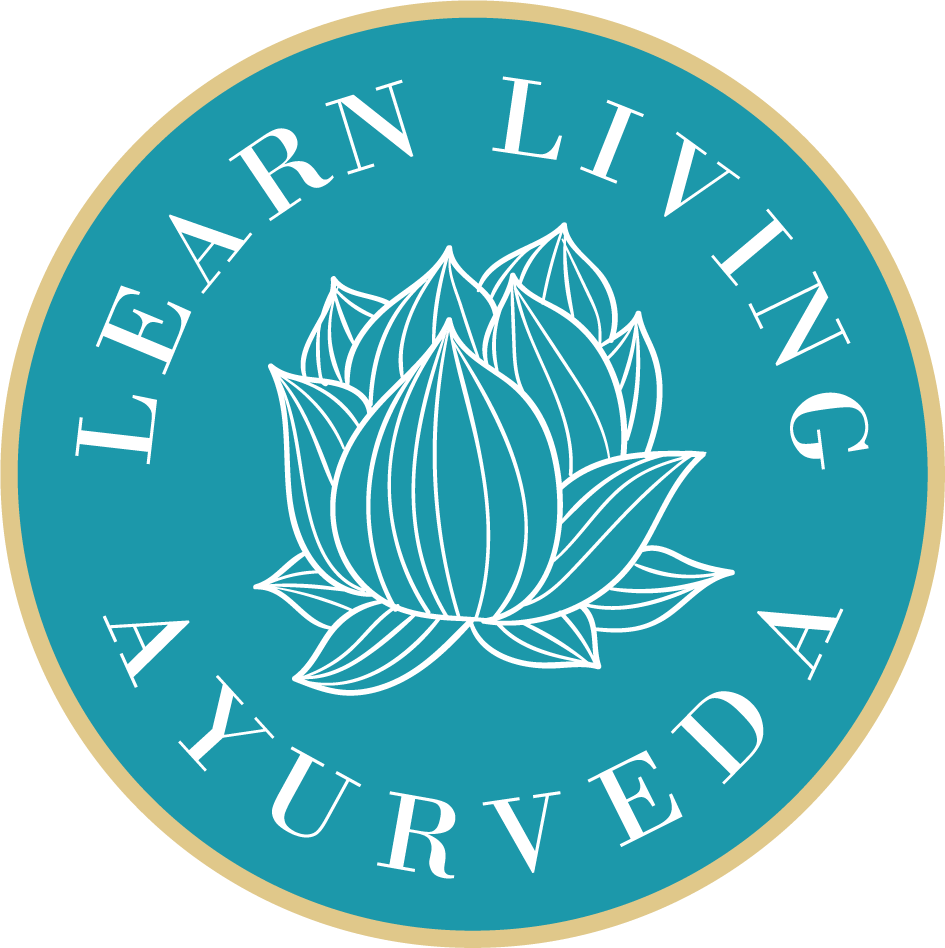Test Chapter 19
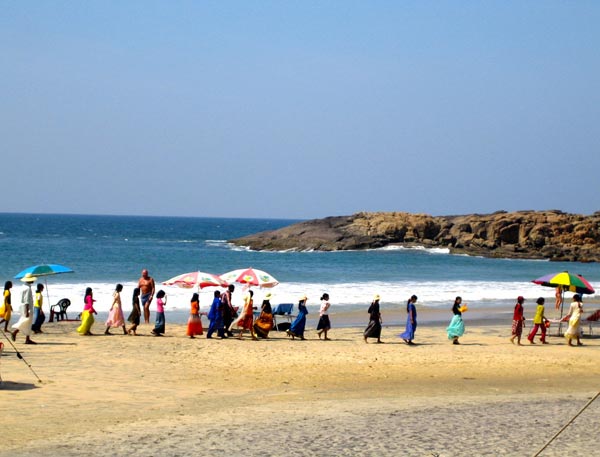
“We all eat from the same soil and sea, breathe from the same sky, and drink the same rain. True health is the result of living harmoniously with the forces of nature…” – David Crow

The unique balance of our doshas give us an invaluable map of our tendencies, vulnerabilities and strengths, helping us to chart our path to health and happiness. While we may recognise many parts of ourselves in descriptions of the three doshic types, we all have our own combination of these energies which is unique to us. The balance of the doshas in our constitution (prakruti) is fundamental to our well-being, as the doshas influence every aspect of our lives. They not only determine our physical shape and attributes, but they also govern every physiological and psychological aspect of our being.
Throughout the course we have presented many of the tools that Ayurveda has to offer us to help us to understand ourselves and to determine our prakruti and vikruti. If your health is generally good, you can incorporate the strategies offered by this amazing system into your lifestyle to maintain the balance of your doshas and thereby maintain your health, prevent disease and enhance your well-being and vitality.
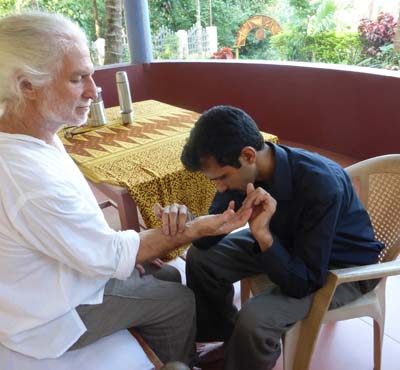 However, if you have health problems or are having a difficult time determining your prakruti or vikruti, a consultation with an Ayurvedic practitioner is highly recommended. Once your prakruti and vikruti have been established through the various diagnostic methods incorporated into the consultation, treatment aimed at balancing the doshas can begin.
However, if you have health problems or are having a difficult time determining your prakruti or vikruti, a consultation with an Ayurvedic practitioner is highly recommended. Once your prakruti and vikruti have been established through the various diagnostic methods incorporated into the consultation, treatment aimed at balancing the doshas can begin.
The aim is not to balance the doshas equally per se but to return to the balance of the three doshas in your prakruti. Learning to observe any changes in the balance of your doshas and knowing how to rebalance them is the key to sustaining health and wellbeing. Ayurveda is such a comprehensive system that if you follow its recommendations, you have the potential to enjoy the vibrant state of health that is the basis of all four goals of life, including the ultimate goal of moksha – liberation and bliss.
The Signs of a Healthy Person
 These are the necessary conditions of a healthy person according to Ayurveda:
These are the necessary conditions of a healthy person according to Ayurveda:
- Samadosha: the doshas are in equilibrium.
- Samagnischa: the digestive fire is in a balanced state to prevent a build up of toxins.
- Samadhatumala: the seven tissues and malas are functioning properly, ensuring that ama is cleared from the system.
- The sensory and motor organs are fully functioning, and the heart and mind are in a state of balance and harmony.
These are reflected in the following signs of good health:
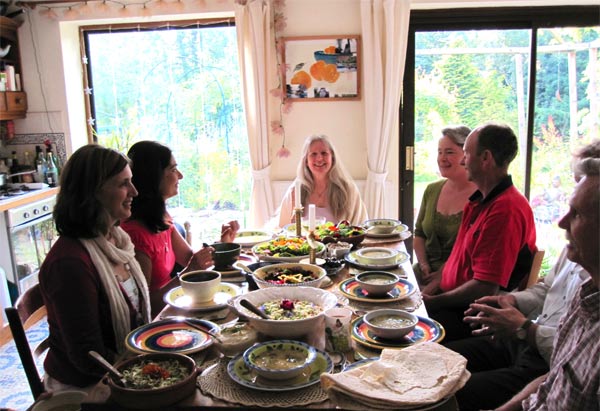
- A healthy appetite and a balanced desire for food without cravings.
- Good digestion without any signs of discomfort.
- Appreciation of the flavour of food and feeling satisfied after eating.
- A clear voice.
- No signs of pain or discomfort.
- A clear complexion.
- Appropriate length and quality of sleep; 6-8 hours a night.
- Regular elimination of stool, urine and sweat.
- Constant energy with good stamina and the ability to exercise.
- Enthusiasm for life.
- Balanced emotions: neither too happy with success nor too sad in times of difficulty.
- The ability to be compassionate, generous and calm.
Strategies for Treatment: Chikitsa
“First do no harm” – The Hippocratic oath
The aim of Ayurvedic treatment (chikitsa) is to balance the doshas, dhatus and malas. To do this firstly it is important to ensure a healthy digestive fire (agni), eliminate any toxins (ama) and clear obstructions in the srotas, and balance prana, tejas and ojas (see Chapter 20 Ayurveda and the Heart and Mind). This should be followed by rejuvenation therapy (rasayana) to enhance continued good health and vitality.
It is useful to be aware of the strategies of treatment that an Ayurvedic practitioner employs in the treatment of patients. This will give us an idea of how to begin to balance ourselves and prevent disease. We have already discussed how to balance agni, clear ama and to cultivate sattva in previous chapters, and in the next chapters we will discuss the care of the heart and mind and describe rejuvenation therapy (rasayana). In this chapter we will focus on foods, herbs, lifestyle, and practices that we can integrate into our lives to balance each dosha. This course will not address the more complex treatment of the dhatus nor the treatment of specific diseases.
1. Assess Prakruti and Vikruti.
In order to maintain health or to treat disturbances of the doshas when they arise, we first need to make an assessment of the balance or imbalance of our doshas. If we are out of balance it means that our doshas have changed from the basic constitution we are born with (our prakruti) to the present state of our doshas (our vikruti). Rebalancing the doshas is central to preventative health since any disturbance of the doshas will eventually lead to ill health. Once symptoms of ill health appear, balancing the doshas is also the first step in the treatment of disease.
As we discussed in Chapter 18, if you consult a practitioner he/she will take a detailed case history and examine you, paying attention to your build, skin and hair type, body temperature, digestion and bowel function and your temperament, all of which point to more profound aspects of your condition. Tongue and pulse diagnosis will be included in your assessment. Once your doshic balance and the state of the dhatus and malas has been diagnosed and the underlying causes of any imbalances have been established, treatment and lifestyle advice is relatively straightforward.
2. Two Types of Shamana
The treatment that we can use at home and most Ayurvedic practitioners in the West employ is known as palliative treatment (shamana) as opposed to pancha karma, which is known as shodana.
Vagbhata, a famous Ayurvedic physician from about the 7th century AD made two broad categories of shamana treatment:
- Langhana meaning reduction
- Brimhana meaning tonification.
1. Langhana reduces, breaks down and detoxifies the body, cleansing it of excess accumulations, toxins and disturbed doshas. It is further divided into:
- Langana proper: cleansing, both shamana and shodhana (see Module 7 Detoxification)
- Rukshana: drying
- Swedana: sweating
Shamana includes the everyday cleansing practices we can use on a regular basis. These can also be used in preparation for shodhana or pancha karma. It can be divided into the following therapeutic measures:
- Dipana: enkindling the digestive fire by using pungent, hot, drying herbs to stimulate the agni (see Module 7 Chapter15. Treatment of Agni).
- Pachana: clearing ama and undigested residues from the gut (see Module 7 Detoxification).
- Vrat or kshud nigraha: fasting (see Module 7 Detoxification).
- Trsna or trn nigraha: fasting from or reducing fluid intake (particularly recommended for excess kapha but only to be done with the advice of a practitioner).
- Vyayama: exercise and yoga.
- Atapa: lightening, drying and reducing the doshas by sitting in the sun and raising metabolism.
- Maruta: lightening and drying the body by sitting in the wind and by breathing practices (see Pranayama Module 6 Chapter 14).

Rukshana or drying therapy involves taking foods and herbs that have diuretic properties to clear excess water from the body. This is used in conjunction with dry massage with powdered herbs and is particularly useful for clearing excess kapha when it manifests in problems such as obesity and diabetes.
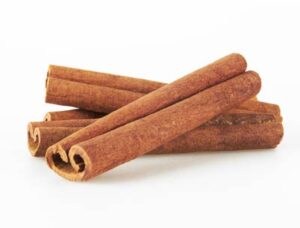 Swedana or sweating involves therapies that increase body heat and cause sweating. They are particularly good for reducing excess vata. They include external application of dry heat or steam or taking warming herbs such as ginger, pepper, trikatu, or cinnamon. The latter are also good for kapha.
Swedana or sweating involves therapies that increase body heat and cause sweating. They are particularly good for reducing excess vata. They include external application of dry heat or steam or taking warming herbs such as ginger, pepper, trikatu, or cinnamon. The latter are also good for kapha.
2. Brimhana is used to nourish, strengthen, enrich and fortify the mind and body and it generally follows langhana. Brimhana is also known as santarpana meaning to indulge or to gladden. It involves the use of nourishing and rejuvenating foods and tonic herbs that build and “gladden” the tissues (we will discuss these more in Chapter 21 Rasayana). It is further divided into:
- Brimhana – using diet and herbs
- Snehana – using oils for oleation
- Stambhana – astringency, using drying or astringent herbs
Brimhana diet and herbs are intended to increase weight and strength and to increase kapha in depleted and debilitated people. They are particularly useful during convalescence, for people who are too thin, weak and run down from excess vata (see Module 8 Chapter 21 Rasayana).

Snehana is the use of oils and fats in the form of ghee or coconut oil, internally and externally to increase lubrication and nutrition. They have a calming, grounding and stabilising effect both physically and mentally and are particularly recommended for disturbance of vata and to a lesser extent pitta.
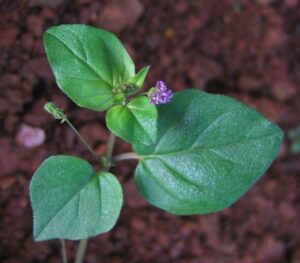
Punarnava
Stambhana is used less frequently and involves using drying and constricting herbs such as punarnava in the picture here, for reducing blood, lymph and other excess fluids in the body. It is particularly used for pitta type bleeding disorders and diarrhoea.
3. Balancing Excess and Deficient Doshas
Throughout the course, we have frequently used the terms “increased,” “disturbed,” “deranged” and “depleted” to describe the state of imbalance of one or more of the doshas. Ayurveda classifies conditions of the doshas as being excess, deficient or vitiated. An imbalance of the doshas involves either too much of at least one dosha, not enough of another or a state of instability or disturbance.
Excess (vridhi) could mean too much heat, cold, dryness, dampness, wind, mucus, ama, mala, and excesses of doshas and dhatus. For example, pitta is increased in hot sunny weather causing prickly heat and irritation. With excess vata there could be deficient bone tissue predisposing to osteoporosis.
Deficient (kshaya) could mean too little heat, moisture, physical strength, digestive energy, mental resilience, and deficient states of the doshas and dhatus. For example, if kapha is deficient, one could have dry mucous membranes, dry skin, cracking joints and a poor memory.
Vitiated (prakopa) means that the doshas, dhatus and agni are disturbed and deranged. For example, vata is often disturbed by a windy storm and this can cause insomnia, pitta can be disturbed by excess alcohol and this can cause jealousy or depression.
4. Similes and Opposites
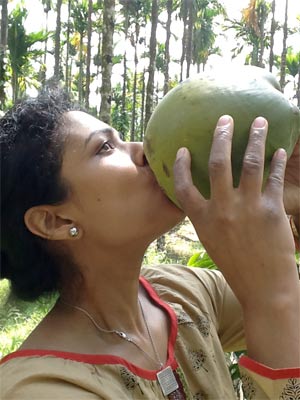 One of the tenets of Ayurvedic treatment is like increases like. We can enhance our health through developing factors of similar nature to it (samanya) and reducing factors that are of contrary nature to it (vishesha). Factors of similar nature to health like rest, good food or meditation, will increase health. Those of an opposite nature like overwork, alcohol, bad diet or stress will detract from it. There is however another tenet that health imbalances are corrected by their opposite. Opposites are medicine!
One of the tenets of Ayurvedic treatment is like increases like. We can enhance our health through developing factors of similar nature to it (samanya) and reducing factors that are of contrary nature to it (vishesha). Factors of similar nature to health like rest, good food or meditation, will increase health. Those of an opposite nature like overwork, alcohol, bad diet or stress will detract from it. There is however another tenet that health imbalances are corrected by their opposite. Opposites are medicine!
A condition of excess heat is corrected through taking cooling foods such as coconut milk and cooling herbs such as chamomile, neem, rose and shatavari. A cold, dry condition of the joint is alleviated by application of warming oils such as ginger. On a psychological level, difficult emotions such as loneliness and anger are never eased by further similar emotions, but by opposite positive attributes of compassion, patience and love.
Excess states of imbalance of the doshas are treated using substances with qualities that are opposite (vishesha) to the disease, while deficient states of imbalance are treated by using foods, herbs and lifestyle recommendations with similar properties (samanya) to that which is deficient. To illustrate, muscle and blood tissue (mamsa and rakta dhatu) are said to be increased by eating red meat, and fat tissue (medas dhatu) is enhanced by eating oils and fats such as ghee. The similar qualities of the food will increase the deficient dosha and thereby balance is restored.
5. The Role of Attributes and Taste in Balancing the Doshas
The world of Ayurveda offers us a wide variety of different ways to remedy imbalances of the doshas, which all involve enhancing our relationship with the world around us; it advises the use of herbal medicines, wholesome foods and lifestyle practices that address every aspect of daily living. The herbs, diet and lifestyle advocated for each individual will vary according their specific effect on the three doshas and depends on their “qualities” and their tastes as well as their post digestive effect (vipaka) and energy (virya).
Qualities or Attributes
Everything that we experience through our five senses has certain qualities or attributes and these arise from the three gunas: sattva, rajas and tamas. Ayurveda names these 20 universal types of energy and organises them into polarities: hot/cold, soft/sharp, dry/wet, heavy/light and so on. The more we become familiar with the energetic qualities of everything around us, the easier it is to discern if a substance or experience will be balancing or disturbing to our constitution.
 After a while, this discernment will become instinctive and an everyday part of making choices. We could ask ourselves, “will this food, herb, activity, seasonal influence or relationship disturb or help balance my constitution?”
After a while, this discernment will become instinctive and an everyday part of making choices. We could ask ourselves, “will this food, herb, activity, seasonal influence or relationship disturb or help balance my constitution?”
With an awareness of the qualities or attributes of foods and herbs, we can make choices about those that we favour to keep our doshas in balance and what to take when imbalances occur. In Module 5, you will find the qualities of each herb, and below you will find lists of herbs that support each dosha. Food and herbs with the opposite quality to that of the dosha will bring balance. So in the case of excess kapha, which is cold and damp, you will need herbs and foods that are warm and dry such as dry ginger and long and black pepper.
The Qualities of the Three Doshas
Vata: Cold, light, dry, subtle, mobile, sharp, hard, rough, clear
Pitta: Hot, oily, light, subtle, liquid, mobile, sharp/penetrating
Kapha: Cold, slow, wet, heavy, dense, static, dull, soft, smooth/slimy, cloudy
For example, excess kapha can cause excess mucus, lethargy, overweight and fluid retention, not to mention a tendency to possessiveness, obstinacy and being sedentary. A diet consisting of warm, dry, light foods that reduce kapha would be advised. Avoiding foods with a cold, damp quality such as wheat and milk products and sugar that increase kapha, would be recommended. Regular vigorous exercise would be suggested, as well as avoidance of getting up late and taking naps in the day. Activities to stimulate the mind and body would best suit kapha types who otherwise might be rather unmotivated and passive. Herbal remedies would include warming spices like ginger, cinnamon, cloves and pepper to raise “digestive fire” and cleanse toxins from the body. Bitters such as turmeric and aloe vera may also be useful.

Tastes
 Each food and herb has a variety of combinations of the six tastes and with an awareness and understanding of the effect on mind and body of these tastes (see Module 4. Chapter 10), we can choose foods and herbs to help maintain the balance of our doshas and to bring them back into balance when we are unwell. This means that foods and herbs can be highly effective tools for the prevention and treatment of imbalance and ill health.
Each food and herb has a variety of combinations of the six tastes and with an awareness and understanding of the effect on mind and body of these tastes (see Module 4. Chapter 10), we can choose foods and herbs to help maintain the balance of our doshas and to bring them back into balance when we are unwell. This means that foods and herbs can be highly effective tools for the prevention and treatment of imbalance and ill health.
Tastes and Doshas
Sweet, sour and salty substances increase kapha and decrease vata,
Pungent, bitter and astringent tastes decrease kapha and increase vata,
Sweet, bitter and astringent taste decrease pitta
Pungent, sour and salty increase pitta.
Making a Herbal Formula
Once you have familiarised yourself with some of the herbs in Module 5, you can design herbal formulae for balancing your doshas and these can be tailor-made for you and your specific needs. It may be helpful to consult an Ayurvedic practitioner to be sure of your assessment of your prakruti and vikruti and to discuss the choice of herbs.
Generally a formula made by a practitioner needs to address a variety of different issues. Digestion and elimination are absolutely central to good health and poor digestion, gut dysbiosis and ama are underlying factors in a whole range of different problems including gut problems, low energy, decreased immunity, allergies, auto-immune disease, obesity and cancer. So herbs for improving digestion and clearing toxicity from the bowel are the first considerations. Then there are herbs that can be added for any imbalances of the doshas, the system of the body affected, whether it is the nervous system in the case of anxiety and insomnia or the respiratory system in the case of bronchitis. Finally, herbs can be included that are specific to the actual symptoms like frankincense for arthritis and gokshura for urinary tract infections.

A recommended method for composing a herbal prescription is to follow the order in which imbalances or health problems need to be treated and using one or two herbs for each aspect of the treatment:
Herbs for the agni
Herbs to clear ama
Herbs to balance the doshas
Herbs to balance the dhatus
Herbs for the specific disease
Herbs to increase sattva and balance the gunas (see Module 6 Chapter 14)
Rejuvenate with tonics
As an example, for the treatment of arthritis with aggravated vata in the asthi dhatu with a low digestive fire and ama a practitioner could use following herbs:
For the agni: ginger, cardamom
For the ama: asafoetida, triphala
For the dosha: ashwagandha, haritaki
For the dhatu: frankincense, guggulu
For the disease: turmeric, gotu kola
Balancing Vata, Pitta and Kapha
To understand the development of symptoms caused by a derangement of the doshas, it is helpful to remember the main sites where each dosha resides and to return to the discussion of the five sub-types of the doshas (Module 3 Chapter 7). The symptoms that develop begin in the main site of the dosha and as they spread they manifest mainly in one or more of the subdoshas of the main dosha involved or in other sites related to that dosha.
The main site of vata is apana vata located in the lower abdomen and colon, which is responsible for all the downward moving impulses of elimination, including defecation, urination, menstruation, giving birth, passing wind and having sex. When apana vata is disturbed it can affect any of these downward moving physiological impulses. Initially, it causes bowel disturbances such as wind, constipation, diarrhoea and irritable bowel syndrome. Apana vata also governs absorption of water in the large intestine and enables us to take in the full nourishment from the digestion of food, the final stage of which occurs in the large intestine.
Apana vata supports and controls all other forms of vata and an imbalance of apana vata is the basis of most vata disorders. So treatment of apana vata is the first consideration in treatment of vata and this will allow the other subdoshas of vata to return to normal functioning. Keeping all five types of vata in balance and properly functioning is the vital key to maintaining health.
Vata, composed of air and ether, is the most mobile dosha in the body and the dosha that most easily goes out of balance. It governs the nervous system and all the subtle movements of the mind. It is estimated that vata is responsible for 70% of all symptoms; according to a report from the U.S. Department of Health and Human Services, 70-80% of all visits to the doctor are for stress-related and stress-induced illnesses.
Disorders of vata are the fundamental basis of most health problems and always accompany those of pitta and kapha. For this reason it is always important to consider apana vata in the treatment of any disease whether it is related to vata, pitta or kapha. Should treatment of apana vata be overlooked, symptoms can then spread (see Chapter 16, The Six Stages of Disease) and manifest in another site of vata such as in the head, mind or chest (prana vata), the throat (udana vata), the stomach and small intestine (samana vata), the circulation (vyana vata) or affect other sites of pitta or kapha.
Generally speaking if one dosha is out of balance, treatment should be relatively straightforward. If two doshas are out of balance it can be more challenging and when three doshas are out of balance it can mean that treatment might be more palliative than curative. When more than one dosha is disturbed, treatment needs to be aimed at balancing the dosha that is causing the most significant symptoms. However, it is important to recognise the role of vata in the development of symptoms. Vata is the mover and changes easily; without vata the other two doshas cannot move into imbalance. For this reason, it is always important to bear in mind redressing the balance of vata in your choice of foods and herbs, even when addressing a pitta or kapha problem. Without vata flowing in balance, pitta and kapha cannot move into equilibrium.
Balancing Principle for each Dosha
Vata—Regularity
Pitta—Moderation
Kapha—Stimulation
Vata

“Do I contradict myself? Very well then, I contradict myself, I am large, I contain multitudes”
– Walt Whitman
Vata people are changeable and dynamic. They can be very enthusiastic at the start of treatment but easily inspired by other ideas or forms of treatment that they may hear about. If you have a lot of vata in your constitution, you may be tempted for example to start another online course in aromatherapy, and become fascinated with dance therapy in addition to studying Ayurveda! It is important to stay grounded and focused and to avoid becoming scattered and overwhelmed with too many things to do.

When beginning to devise a plan to treat vata in oneself or to advise someone else, start with small changes that are easy to integrate into your life and make part of a regular daily routine. This will help to prevent you from forgetting your diet, to take your herbs and then remaining in an imbalanced state! Vata types are generally forgetful and their creative nature makes adhering to regular schedules and activities a bit of a chore. However, it is the regularity and stability of a daily routine that gives vata the grounding so necessary for balance and health. Vata people may enjoy the creative process of devising a dinacharya with a variety of vata-reducing practices. Then, encouragement and support is helpful to keep them on track.
Signs of Vata Aggravation
When vata is aggravated, your system becomes irregular and depleted, which weakens organs and tissues.
- Irregular appetite.
- Irregular lifestyle.
- Wind and bloating.
- Constipation, colic, and explosive diarrhoea (aggravated by anxiety).
- Dehydration and dry skin.
- Insecurity, fear, tension, anxiety, mental agitation, depression and restlessness.
- Talking too much.
- Feeling cold and poor circulation.
- Craving warmth, warm foods and drinks.
- Frequent infections and lowered immunity.
- Disturbed sleep and insomnia.
- Low energy and fatigue.
- Loss of weight.
- Weakness and depletion of the tissues.
- Aching pain in the bones, dry cracking joints, joint pain, arthritis and lower back ache.
- Dry skin and hair and brittle nails.
- Pain: cutting and migrating.
- Neurological problems, tinnitus, tingling and numbness, tremors, poor coordination, disorientation and dizziness.
 Symptoms are worse at dawn or dusk and at the vata time, between 2–6 am and pm. The vata time of life is 50 into old age and vata symptoms may be especially pronounced then. The cold and windy weather of autumn and early winter aggravates vata symptoms and warmer weather improves them.
Symptoms are worse at dawn or dusk and at the vata time, between 2–6 am and pm. The vata time of life is 50 into old age and vata symptoms may be especially pronounced then. The cold and windy weather of autumn and early winter aggravates vata symptoms and warmer weather improves them.
“A branch shorn of leaves
A crow perching on it-
This autumn eve” – Basho
In order to keep vata in balance or to calm it when it is out of balance, it is helpful first of all to understand what actually deranges vata in the first place.
Causes of Vata Aggravation
- Irregular, erratic lifestyle, irregular eating patterns and missing meals.
- Stress, strain, grief, anxiety, fear, shock and loneliness.
- Changes of all kinds: moving house/school/work/relationship/weather/country.
- Flying, travelling, changing climate, time zones, foods, environment and routine.
- Change of season especially autumn.
- Dawn and dusk: 2-6 am and pm
- Too much movement, exercise, running, jumping and rushing.
- Suppression of natural urges: eating when hungry, urination and passing bowel movements when the urge comes, passing wind, resting or sleeping when tired.
- Exposure to cold, dry, windy weather and air conditioning.
- Drinking too much cold and icy water.
- Being over the age of 50.
- Lack of sleep, overwork and exhaustion.
- Excess bitter, pungent and astringent foods.
- Eating excess dry, light, rough, cold foods straight from the fridge or cold, raw foods such as salad.
- Talking too much.
- Loud noise and discordant sound.
- Overstimulation and doing too much, doing to many things at the same time such as eating and watching TV, sending a text while walking in a busy street!
The Main Sites of Vata
The lower abdomen and pelvic cavity including the large bowel (colon) and the genito-urinary tract
The hips and thighs
The bones and joints
Nerve tissue and the mind
The ears
The skin
Treatment of Vata
General Dietary Guidelines
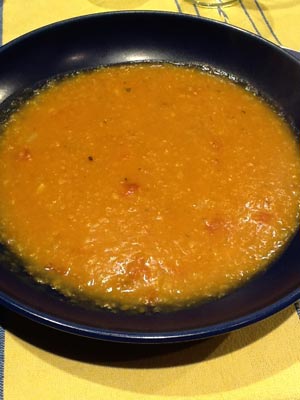
- The ideal diet is one that is warm and easy to digest such as boiled, steamed or roasted starchy vegetables, ripe fruits, warm milk, cooked vegetables, and soupy grains like rice and wheat.
- Mild spices and culinary herbs including cumin, ginger, cardamom, cinnamon, fennel, coriander, salt, cloves, mustard and black pepper can be added to help raise the digestive fire and enhance the assimilation of nutrients which will help nourish the nervous system.
- Ideal drinks are warm fennel, ginger and licorice tea.
- Eat at regular times and avoid eating either too much or too little.
- Avoid yeast, refined sugars, coffee, tea, tobacco, drugs, and poor quality oils. Increase foods that are warm, heavy, and oily as these nourish the nervous system. Soups, stews and casseroles, with plenty of mild spices are ideal. Kichari is also great food for vata.
- Reduce foods that are cold, dry, and hard such as salads and raw nuts as these aggravate digestion.
- Favour foods that are sweet (e.g. wheat, milk, rice), sour (eg. vinegar, yogurt, fermented vegetables, umeboshi plums, citrus fruit), and salty as these are all nourishing and balancing.
- Reduce foods that are bitter (e.g. coffee, green leafy vegetables), very spicy foods (chillies) and astringent (e.g. apples, beans) as these aggravate digestion and disturb the nervous system.

VATA REDUCING DIET
| DECREASE | INCREASE |
| F R U I T S | |
| Dried fruits Raw Fruits Cranberries Persimmon Watermelon Pears Pomegranate Raw Apples | Sweet Fruits Apricots Avocado Bananas (Ripe) Berries Cherries Coconut Dates (Fresh) Figs (Fresh) Grapefruit Grapes Mango Melons (Sweet) Peaches Papaya Pineapples Plums Prunes (Soaked) |
| V E G E T A B L E S | |
| Raw Vegetables Brussels Sprouts Cabbage Cauliflower Leafy Greens Celery Lettuce Aubergine Mushrooms Onions (Raw) Parsley Peas Peppers Potatoes Spinach Sprouts Tomatoes Broccoli Bitter Melon Turnips Brocolli Salad Kohlrabi Raw cabbage | Cooked Vegetables Beetroot Butternut squash Carrots Cucumber Fennel Garlic Green Beans Leafy Greens Leeks Okra (Cooked) Onion (Cooked) Parsnips Peas (cooked) Potato (Sweet) Pumpkin Radishes Courgette/zucchini Asparagus Seaweeds Squash |
| G R A I N S | |
| Barley Bread with yeast Buckwheat Corn Dry cereals Dry crackers Millet Muesli Oats (dry) Rye Tapioca | Oats (cooked) Quinoa R i c e ( basmati ,brown, wild) Pasta Wheat |
| A N I M A L F O O D S | |
| Lamb Pork Rabbit Venison | Beef Chicken, Duck or Turkey (white meat) Eggs (fried or scrambled) Salmon Sardines Seafood White fish |
Dairy: all dairy products nourish the nervous system but need to be organic. Cheese is best avoided, especially hard cheese as it is hard to digest. Always boil milk before you drink it, add a few cardamom seeds while heating it and drink it warm. Don’t take milk with a full meal or with fruit. If you are allergic to cow’s milk, substitute with almond, coconut, hazelnut, oat or rice milk. Avoid ice cream, powdered milks and soya milk.
Sweeteners: all sweet flavours are good for nourishing vata and the nervous system. Reduce refined white sugar. Avoid all sugars if bloating is present as it may indicate the presence of ama.
Oils: all unrefined oils are good as they reduce the dryness of vata and nourish the nervous system. The best oils for vata include flax, hemp, sesame, ghee, olive, sunflower, evening primrose, borage and fish oils. These can be used both internally and externally.
Grains: rice (basmati, brown, wild), wheat, oats (cooked) and quinoa are very good for nourishing vata and the nervous system. Amaranth is also fine. Reduce the intake of barley, corn, millet, buckwheat and rye as these are a bit drying and can be difficult to digest, creating flatulence. Avoid the other grains.
 Fruits: sweet, sour, and heavy fruits, such as berries, bananas, avocados, grapes, cherries, lemons, limes, fresh figs, peaches, melons, plums, pineapples, mangoes, and papayas are best. Cooked apples and pears, soaked prunes and raisins are all fine. Avoid dried fruits, uncooked apples, pears, pomegranates, and cranberries as these can create flatulence.
Fruits: sweet, sour, and heavy fruits, such as berries, bananas, avocados, grapes, cherries, lemons, limes, fresh figs, peaches, melons, plums, pineapples, mangoes, and papayas are best. Cooked apples and pears, soaked prunes and raisins are all fine. Avoid dried fruits, uncooked apples, pears, pomegranates, and cranberries as these can create flatulence.
 Vegetables: asparagus, beets, cucumbers, carrots and sweet potatoes are the best. Peas, green leafy vegetables, celery, summer squash, winter squash and potatoes are best well cooked in oil or ghee with mild spices. Seaweeds are very beneficial. It’s best to avoid the Brassica family: Brussel sprouts, kale, collard greens, broccoli, cauliflower and cabbage. Also avoid Solanaceae family: peppers, aubergines/eggplant, potatoes and tomatoes. Raw vegetables, especially onions are banned as these all create flatulence.
Vegetables: asparagus, beets, cucumbers, carrots and sweet potatoes are the best. Peas, green leafy vegetables, celery, summer squash, winter squash and potatoes are best well cooked in oil or ghee with mild spices. Seaweeds are very beneficial. It’s best to avoid the Brassica family: Brussel sprouts, kale, collard greens, broccoli, cauliflower and cabbage. Also avoid Solanaceae family: peppers, aubergines/eggplant, potatoes and tomatoes. Raw vegetables, especially onions are banned as these all create flatulence.
Spices: Most spices are good, especially asafoetida, cardamom, cumin, coriander, ginger, fennel, dill, cinnamon, salt, cloves, mustard seed and black pepper. They help regulate apana vata and reduce wind and spasm in the digestive system. Avoid hot spices like chilli, dried ginger and horseradish.
Nuts: all nuts and seeds are good in moderation for vata, especially when they have been soaked or ground.
Beans: avoid all beans, except for marinated tofu, mung beans, urad dhal and occasionally red lentils.
Meat and fish: chicken, turkey, eggs and seafood are fine; beef and other red meats that are hard to digest should be avoided.
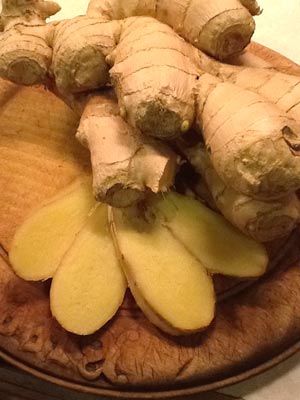
General Treatment of Vata (Vata Shamana)

- Plenty of relaxation, rest and sleep.
- Avoid overstimulation and doing too much.
- Practices to reduce anxiety including yoga, pranayama, walking meditation.
- Spend quiet times in nature observing silence.
- A regular routine including eating meals regularly.
- Massage and oils. Internal and external use of oils particularly sesame oil (see below), followed by application of heat or a warm bath or shower. Oils used for external use include: nilyadi oil, sesame oil, narayan oil, mahanarayan oil and castor oil. Use ghee in food.
- Light purgation using triphala.
- Nasal administration of oil (nasya): helpful for dryness and for mental and emotional imbalances.
- Shirodhara.
- Eat a light diet, with warm soft foods and avoiding hard, raw, dry and indigestible foods.
- Mild spices such as fresh ginger, cumin, cardamon, fennel, coriander.
Increase sweet, sour and salty foods and minimise pungent, bitter and astringent foods.
Herbs

Herbs that are particularly aimed at balancing apana vata include: ashwagandha, shatavari, asafoetida, brahmi, bala, gokshura, guduchi, dill, celery seed, ginger, long pepper, haritaki, guggul, licorice, saffron, tulsi, valerian, cardamom, cinnamon, fenugreek, garlic, coriander, cumin, nutmeg, turmeric, frankincense, clove.
- Vata formulae: triphala guggulu, hingwastaka, talisadi, trikatu, trikulu.
- Rejuvenatives (rasayanas): ashwagandha, shatavari, bala, gotu kola, and chayawan prash as a genenal tonic.
- Rasayanas for digestion: trikatu and hingwastaka.
Teas
The following herbs and spices can be taken singly as teas or made into mixtures of your choice: fresh ginger, cardamom, tulsi, clove, fennel, lemongrass, oat straw, peppermint and cinnamon.
Vehicles for Herbs (Anupan)
Warm milk, hot water and ghee
Two Categories of Vata Treatment
Treatment of vata is divided into two categories, according to whether one is depleted and there is tissue deficiency (dhatukshaya), or whether there is tension and contraction or ama causing obstruction of the channels (srotorodha).
1. Dhatukshaya: Where there is deficiency you can feel run down and weak and be under-weight and undernourished; in this case nourishing therapy (brimhana) is indicated. A vata-reducing diet is recommended, making sure first that the digestive fire is good, as nourishing foods tend to be heavy and can cause ama if not completely digested. If there is low digestive fire or ama, digestive herbs such as ginger, black pepper or cardamom can be taken. Light sesame oil massage is recommended and fomentation with vata-reducing herbs and formulae such as dashmula. Sudation or sweating therapy with steam is very helpful. Arishtas can be taken before meals to enhance the appetite or after eating as a tonic; draksharishta or ashwagandharishta are recommended. Vata-reducing herbs such as ashwagandha, bala, and shatavari can be taken. Gentle yoga with sitting postures and meditation are good.
2. Srotorodha: Obstruction of the channels (srotas) is indicated by pain and symptoms such as asthma, arthritis and constipation. In this case detoxifying and stimulating herbs such as fresh ginger and fennel are recommended. Oil massage with sesame oil is helpful. Mild laxatives such as triphala and decoction enemas will help to open the channels. Boswellia (frankincense) is excellent for clearing ama and blockage of the srotas. Once the system has been cleared, a general vata-reducing diet can be followed and tonic herbs such as ashwagandha can be taken.
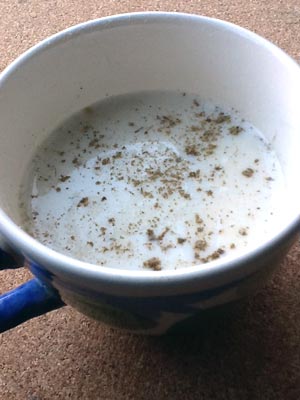 Soothing bedtime drink for a sound sleep
Soothing bedtime drink for a sound sleep1 cup almond, coconut or rice milk
2 tsp organic ground almond powder
2 cardamom pods
5 strands saffron
1 tsp rose water
A pinch of nutmegHeat all the ingredients together slowly and add 1 tsp of honey if you wish. Stir in ½ to 1 tsp of organic ashwagandha powder and take at night before bed. Ashwagandha is a highly nourishing, rejuvenating and strengthening herb for vata. This recipe also helps to nourish the nerves and the reproductive system and has a grounding, yet energising effect on body and mind.
Exercise and Yoga
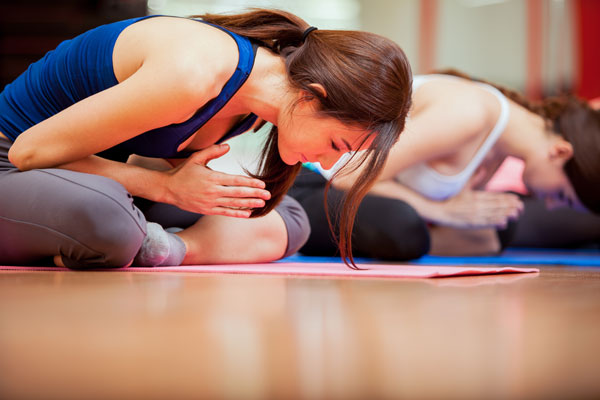
Vata people tend to be so active and mobile, that gentle moderate exercise like walking in nature, yoga, tai chi and gentle dance are the most balancing. Yoga is the sister science to Ayurveda and naturally fits within an Ayurvedic lifestyle. Yoga helps deepen our awareness of being in the body and sensing subtle sensations and feelings. All the postures that build stability, strength and groundedness, while encouraging stillness and slow movement, will be highly beneficial and restorative for vata. Although some heat, especially in winter months, can be soothing, hot yoga is generally too heating and vigorous and can easily disturb vata. A simple home practice of yoga could include: child, knee to chest, backward bend, cat/cow, cobra, yoga mudra, plough, mountain, warrior, slow sun salutation sequence, and corpse.
Massage
“Oil massage releases repressed emotions. Emotions become stuck in the muscle and the flow of awareness is blocked. The subtle quality of sesame oil helps to release those emotions by stimulating certain neurotransmitters in the central nervous system” – Dr. Vasant Lad
 One of the most stabilising and balancing treatments for vata is massage. Vata people crave love and support in the form of touch, and with the soothing, calming, nourishing addition of sesame oil, massage becomes a highly effective medicine. The Sanskrit word sneha translates as both “oil” and “love.” So, oiling the skin regularly can impart the warmth and security of feeling loved; this alone is transformative for vata.
One of the most stabilising and balancing treatments for vata is massage. Vata people crave love and support in the form of touch, and with the soothing, calming, nourishing addition of sesame oil, massage becomes a highly effective medicine. The Sanskrit word sneha translates as both “oil” and “love.” So, oiling the skin regularly can impart the warmth and security of feeling loved; this alone is transformative for vata.

Sesame oil is ideal for vata; mahanaryan oil is also good. Warmed sesame oil relaxes muscles, calms the nervous system and nourishes the largest organ of the body—the skin. A daily massage (abhyanga) with therapeutic oils is highly recommended for vata imbalances including insomnia, stress, lowered immunity and anxiety. Later in this chapter, we will discuss the therapeutic value of sesame oil and how to give yourself an oil massage.
Pitta

Pitta types are perfectionists; once they decide to commit to getting themselves well, they will have the self-discipline to adhere strictly to a pitta-reducing diet and take their herbs precisely on time! They are likely to have list of foods they can or cannot eat stuck to their fridge and the right teapots and containers for their herbs. They like to be organised and do things properly. For this reason it is often easy for them to get the best out of Ayurvedic treatment.

“Just do it!”
– Nike Brand
A person in state of high pitta can also be so hard on themselves that they feel they will never do anything perfectly or achieve a perfect state of health, so why bother! Or they can be so extreme about following everything precisely that they burn out and give up. Pitta people fear failure and this can be a block to getting well. It is important to offer encouragement, to keep expectations attainable and to make gradual changes.
Signs of Pitta Aggravation
- Heat, burning sensations, fevers and profuse sweat.
- Dislike of heat and wanting to be in a cool place/climate.
- Thirst and desire for cool foods and drinks.
- Increased appetite, low blood sugar and dizziness.
- Inflammation of the stomach and intestine; heartburn, acidity, gastritis, peptic ulcers and appendicitis.
- Inflammatory skin problems: eczema, hives, vitiligo, herpes, boils and rashes.
- Infective skin problems: boils, impetigo and acne.
- Tonsillitis and bronchitis.
- Blood disorders: anaemia and high blood pressure.
- Bleeding tendency: nosebleeds and heavy periods.
- Loose stools and diarrhoea.
- Colourful and violent dreams.
- Frequent bacterial infections.
- Eye problems such as conjunctivitis, styes and blepharitis.
- Liver and gall bladder problems including hepatitis.
- Yellowish discolouration of the eyes, skin, nails, teeth and urine.
- Cystitis, burning urination and urinary tract infections.
- Headaches and migraine.
- Hormonal problems, PMS, and hot flushes during menopause.
- Irritability, intolerance, anger, aggression, envy, jealousy, being critical and self-critical, perfectionism, arrogance, over-competitiveness, obsessions, anorexia, addictions, alcoholism, insomnia.

Symptoms are worse in heat and at the pitta time between 10-2 am and pm. The pitta time of life is adulthood from 18 to 50 and pitta problems may be pronounced then. The heat of the late spring and summer aggravates pitta symptoms and the cooler weather of late autumn and winter improves them. In order to keep pitta in balance or to calm it when it is out of balance, it is helpful first of all to understand what actually causes pitta to go out of balance in the first place.
Causes of Pitta Aggravation
- Heat and damp. Hot weather and getting overheated.
- Bright light and hot sun.
- Late spring and summer.
- Inflammatory situations and relationships.
- Anger, jealousy, arguments, irritation and frustration.
- Perfectionism and over-ambition.
- Between 10-2 am and pm (midday and midnight).
- Missing meals.
- Suppression of emotions.
- Being aged 18-50.
- Overwork, over-commitment and overly-competitive environment.
- Hot foods and drinks.
- Excessive pungent, sour and salty foods.
- Fried foods, excess chilli, black pepper and mustard.
- Caffeine, hot spices and alcohol.
- Going to bed late and working through the night.
- Too much reading at night.

The Main Sites of Pitta
Stomach and small intestine
Liver and gallbladder
Blood
Skin, sweat and sebaceous glands
Heart and mind
Eyes
Treatment of Pitta
General Dietary Guidelines
 Drink plenty of cool water every day.
Drink plenty of cool water every day.- Add a little rosewater to your drinking water.
- Avoid alcohol, coffee, tea, chocolate, cheese, yogurt and red meat.
- Avoid poor quality oils as they contribute to inflammation.
- Use ghee, organic coconut oil or cold pressed olive or sunflower oil.
- Avoid sour, salty, and spicy/pungent foods.
- Increase foods that are sweet, bitter and astringent.
- Increase foods that are cool, refreshing and liquid: fresh, sweet, organic fruits and vegetables (boiled or steamed), salads, moderate amounts of dairy and soupy grains.
- Add mild, cooling spices like coriander, cloves, turmeric, cumin, curry leaves and fresh mint to your meals.
- Drink teas of fennel, chamomile, peppermint, spearmint, licorice and red clover regularly.

PITTA REDUCING DIET
| DECREASE | INCREASE |
|---|---|
| F R U I T S | |
| Sour fruit Apricots Berries Bananas Cherries Cranberries Grapefruit Grapes (green) Lemons Oranges (sour) Plums (Sour) Papaya Peaches Pineapples (sour) Persimmon | Sweet Fruits Apples Avocado Coconut Figs Grapes (dark) Mango Melon Oranges (sweet) Pears Pineapples (sweet) Plums (sweet) Pomegranate Prunes Raisins |
| V E G E T A B L E S | |
| Pungent vegetables Beets (raw) Carrots Aubergine/eggplant Garlic (raw) Onions (raw) Peppers (hot) Radishes Spinach Tomatoes | Sweet & bitter vegetables Asparagus Beets (cooked) Broccoli Brussels sprouts Cabbage Cucumber Cauliflower Celery Green beans Leafy greens Lettuce Mushrooms Okra Parsley Peas Peppers (Green) Potatoes Courgette/zucchini Sprouted beans |
| G R A I N S | |
| Buckwheat Corn Millet Oats (dry) Rice (Brown) Rye | Barley Oats (Cooked) Rice (Basmati) Rice (White) Wheat |
| A N I M A L F O O D S | |
| Beef Eggs (yolk) Lamb Pork Seafood | Chicken, turkey (white meat) Eggs (white) Pheasant Rabbit Shrimp (Small Amount) White fish Venison |
| D A I R Y & O I L S | |
| Buttermilk Cheese Sour Cream Yoghurt Almond Corn Safflower Sesame | Butter (unsalted) Cottage Cheese Ghee Milk Coconut Olive Soy Sunflower |

Dairy: Milk, butter and ghee are good for reducing heat. Avoid yogurt, cheese, sour cream and cultured buttermilk. These sour tastes can aggravate inflammation.
Sweeteners: All sweeteners are good except for honey and molasses.
Oils: Ghee, flax, hemp, borage, evening primrose, olive, sunflower and coconut oils are best. Reduce sesame, almond and corn oil, all of which increase heat.
Grains: Wheat, basmati rice, barley and oats are good. Reduce corn, rye, millet and brown rice as they are a little heating.
F ruits: Increase sweet fruits such as grapes, limes, figs, cherries, melons, avocado, pomegranates, mangoes, apples, berries, sweet and fully ripened oranges, pineapples and plums. Reduce sour fruits such as grapefruits, lemons, olives, papayas and sour, not-yet-ripened oranges, pineapples and plums as they can increase heat and acidity.
ruits: Increase sweet fruits such as grapes, limes, figs, cherries, melons, avocado, pomegranates, mangoes, apples, berries, sweet and fully ripened oranges, pineapples and plums. Reduce sour fruits such as grapefruits, lemons, olives, papayas and sour, not-yet-ripened oranges, pineapples and plums as they can increase heat and acidity.
V egetables: Increase asparagus, cucumber, cooked beetroots, sweet potatoes, green leafy vegetables, pumpkins, summer squash, broccoli, collard greens, kale, cauliflower, celery, okra, lettuce, sprouted beans, peas, green beans. Avoid foods in the Solanaceae nightshade family including: hot peppers, bell peppers, tomatoes, aubergines/eggplant, potato (some is ok). Also avoid the Allium family especially raw onions, garlic, radishes. Also avoid raw spinach and mustard greens as these increase heat and acidity.
egetables: Increase asparagus, cucumber, cooked beetroots, sweet potatoes, green leafy vegetables, pumpkins, summer squash, broccoli, collard greens, kale, cauliflower, celery, okra, lettuce, sprouted beans, peas, green beans. Avoid foods in the Solanaceae nightshade family including: hot peppers, bell peppers, tomatoes, aubergines/eggplant, potato (some is ok). Also avoid the Allium family especially raw onions, garlic, radishes. Also avoid raw spinach and mustard greens as these increase heat and acidity.
Beans: All legumes are fine except miso and soy sauce.
Nuts and Seeds: None except coconut. Especially avoid peanuts as these can create inflammation. No seeds except sunflower and pumpkin.
Spices: Cinnamon, coriander, dill, aniseed, cardamom, fennel, turmeric, fresh ginger, long pepper and small amounts of black pepper are good, but the following spices strongly increase heat and should be taken in moderation: asafoetida, dry ginger, cumin, fenugreek, clove, celery seed, salt and mustard seed. Chilli peppers and cayenne should be avoided.
Meat and Fish: Chicken, pheasant, and turkey are preferable. Beef, pork, seafood and egg yolk can increase inflammation.
“Preserving the health by too strict a regimen is a wearisome malady”
– François Duc de la Rochefoucauld
General Treatment of Pitta (Pitta Shamana)
“Sitting quietly,
doing nothing, Spring come, and the
grass grows by itself”
– Basho
- Relaxation and rest and going to bed early by 10pm is ideal.
- Relax in cool places, by water, swimming and walking by the sea.
- Avoid overwork and burning the candle at both ends.
- Avoid excessive exercise especially when it’s hot.
- Avoid inflammatory situations, stressful people and situations.
- Drink plenty of cool water. Coconut water is also deliciously cooling.
- Take cool baths with cooling herbs or essential oils including chamomile, lavender, sandalwood, geranium, jasmine, lemongrass or rose.
- Practice pranayama such as alternate nostril breathing.
- Take gentle laxatives such as licorice, dandelion root or triphala to reduce excess pachaka pitta.
- Take 30-60 mls/1-2 ounces of aloe vera juice daily.
- Massage with oils: coconut or sunflower oil, sandalwood, bringaraj, nilyadi or brahmi oil.
- Read or listen to inspirational authors of fiction, poetry or spiritual essays.
- Try counselling, talking, singing, writing or meditation to release suppressed emotions such as anger.
- Listen to soft words or music.
- Walk in the moonlight.

- Do uncompetitive activities like walking, drawing, painting or writing poetry.
- Eat plenty of sweet, bitter and astringent foods and herbs.
- Reduce pungent, spicy, fried, sour and salty foods.
- Avoid alcohol, tobacco, stimulants and recreational drugs.
- Use pure rose or sandalwood oil as a perfume.
- Put sandalwood oil or paste of the powder on the third eye between the eyebrows.
Herbs
- Coriander, chamomile, cumin, rose, bacopa, gotu kola, Bhringaraj, sariva, gokshura, aloe vera, amalaki, turmeric, shatavari, guduchi, punarnava, manjishta, neem, licorice, saffron
- Formulae: mahasudarshan; pippaliamla; nimbadi; pushyanuga; mahatikta ghrita
- Rasayana: amalaki, shatavari, aloe vera, guduchi. Brain rasayana: gotu kola
Teas
Drink plenty of teas, luke warm to cool. Choose from chamomile, hibiscus, licorice, cumin, coriander, fennel, rose, gotu kola, mint, lemongrass and dandelion coffee.
Vehicles for Herbs (Anupan)
Aloe vera juice, ghee, cool water

Medicines prepared in ghee are good nerve tonics for pitta, as ghee nourishes the brain and the nerves and enhances digestion and absorption. Ghee combines well with bitter herbs, enhancing their properties through its pitta reducing properties. Pitta reducing medicines are usually followed by milk.
Exercise and Yoga

The pitta person is the one we see winning the gold medal and attempting dangerous feats of physical mastery. Playing sports and being competitive is thoroughly satisfying for pitta, however too much competition or a highly competitive state of mind increases pitta. Pitta types tend to over-exercise, so they benefit from bringing the intention of relaxation, play and joy into their choice of exercise. Walking, biking, swimming, hiking and gentle yoga are good choices. Yoga with an emphasis on building strength and heat can exacerbate the pitta tendency to accumulate heat, to crave intensity and to push oneself. Having fun, releasing self-judgement and allowing creativity in yoga practice is very balancing. A simple home practice of yoga could emphasise moderation, moving at one’s own pace, and releasing heat: forward bend, mountain, moon salutation, the child, spinal twists, boat, shoulder stand, half bow, cobra and corpse.
Useful Recipes for Pitta
Shatavari Kalpa
Shatavari kalpa is a useful remedy for pitta women. It is particularly good for digestive symptoms such as low blood sugar, heartburn and indigestion. It also helps regulate menstruation and can be taken daily during pregnancy and the menopause.
To make this, roast an ounce of shatavari with one or two tablespoons of ghee in a cast iron pan until it turns light brown. Then add two tablespoons of jaggery or coconut sugar, two strands of saffron and a pinch of cardamom. Take a teaspoon in the morning.
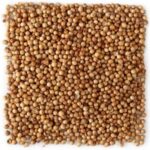
Coriander
Coriander seeds can also be crushed or ground and added to a lassi or takram. A delicious recipe to aid digestion and absorption can be made from:
Two tablespoons of yoghurt
One cup of water
A teaspoon of ground coriander seeds
A teaspoon of rose water
To cool heat especially during the menopause, you can soak 3 tablespoons of coriander seeds overnight in a cup of cold water. Strain and drink the water in the morning.
To make a good pitta-reducing coffee substitute, roast and grind coriander seeds and steep them in hot water for a while before drinking.
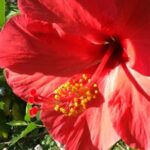
Hibiscus
Hibiscus is wonderfully cooling remedy for pitta and makes a good tea for pitta people, especially when combined with rose petals.
Superfoods
Chlorella, spirulina, wheat grass, barley grass and seaweeds all help to cool the system and clear inflammation.

Rose
On hot summer nights, pitta people can stir a teaspoon of rose water into their cup of warm milk at bedtime.
Kapha

“The sweetness of having nothing one must do”
– Italian proverb
Kapha types are generally strong and resilient and so do not tend to get ill often. When they do, the symptoms are likely to be mild and non-serious such as a cold or excess mucus. As well as being resilient, they are also fairly stoical, so they are likely not to make a fuss about their symptoms and will not readily seek treatment until symptoms have progressed somewhat. Once they start treatment they will generally stick at it but symptoms will be slow to change because of the stable nature of kapha. They need encouragement to try new things and to develop a different lifestyle, and to accept the fact that the pace of their improvement could be slow.
Signs of Kapha Aggravation
- Mucus congestion, coughs, bronchial congestion.
- Frequent colds, sinus congestion.
- Hay fever, asthma.
- Mental and physical stagnation.
- Heavy and lethargic feeling, sleepiness, laziness, poor concentration, foggy mindedness.
- Deep, heavy sleep.
- Difficulty waking up in the morning.
- Low agni, slow digestion and metabolism.
- Excess salivation, nausea and heaviness after eating.
- Sluggish bowels, constipation.
- Poor appetite.
- Thick white tongue coating.
- Water retention, puffiness.
- Swollen and watery joints.
- Pale skin.
- Cold, damp hands and feet.
- Weight gain, obesity, metabolic syndrome, type 2 diabetes.
- High cholesterol.
- Low thyroid function.
- Craving warmth and spicy foods.
- Lymphatic congestion.
- Poor circulation.
- Possessiveness, acquisitiveness, greed, stubbornness, aversion to change, blocking out emotions.
Symptoms are worse in cold damp weather in the winter and early spring and between 6-10 am and pm. Kapha governs growth and the formation of tissue, so childhood and pregnancy are also times when kapha predominates and symptoms may develop.
In order to keep kapha balanced or to calm it when it is out of balance, it is helpful first of all to understand what actually increases Kapha in the first place.
Causes of Kapha Aggravation
- Sleeping in the daytime, excessive sleep, getting up late.
- Lack of exercise, not doing very much, laziness, a sedentary occupation.
- Cold damp weather, winter, cold and damp environments.
- 6-10 am and pm.
- Not eating regularly, overeating.
- Excess sweet, sour and salty foods.
- Excess heavy, oily, cold and damp foods such as yoghurt, cheese, butter, milk, meat as well as watery fruit and vegetables like cucumber, melons, oranges and grapes.
- Whole grains such as wheat and rice.
- Greed and attachment, hoarding things.
Main Sites of Kapha
Stomach, mouth and tongue
Respiratory system, throat and mucous membranes
Head
Pancreas
Lymph
Fat tissue
Treatment of Kapha
General dietary Guidelines
- Avoid yeast, salt, cheese, yoghurt, chocolate, and refined sugars and flours as these increase mucus.
- Avoid overeating, especially at night.
- Avoid eating when you are not hungry.
- Don’t eat between meals.
- Don’t eat cold foods or drink cold drinks.
- A primarily vegetarian diet is highly recommended.
- Include ginger in your daily diet: grate a little fresh ginger root and add it to fresh lemon juice in warm water before each meal.
- Increase foods that are light, dry, and warm as these reduce mucus.
- Reduce foods that are heavy, oily and cold as these increase weight and mucus.
- Increase foods and herbs that are spicy, bitter, and astringent (ginger, turmeric, cumin, coriander, caraway, cloves, green tea, bitter greens, apples, cabbage) as these help to dry excess fluids in the body.
- Reduce foods that are sweet, salty, and sour (cakes, crisps, vinegar) as these increase fluids in the body.


KAPHA REDUCING DIET
| DECREASE | INCREASE |
|---|---|
| F R U I T S | |
| Sweet & Sour Fruits Avocado Bananas Coconut Figs (fresh) Grapefruit Grapes Lemons Melon Oranges Papaya Pineapples Plums | Apples Apricots Berries Cherries Cranberries Figs (dry) Mango Peaches Pears Persimmon Pomegranate Prunes Raisins |
| V E G E T A B L E S | |
| Sweet & Juicy Vegetables Courgette/zucchini Cucumber Potatoes (Sweet) Tomatoes | Pungent & Bitter Vegetables Asparagus Beets Broccoli Brussels Sprouts Cabbage Carrots Cauliflower Celery Aubergine/eggplant Garlic Leafy Greens Lettuce Mushrooms Okra Onions Parsley Peas Peppers Potatoes (white) Radishes Spinach Sprouted beans |
| G R A I N S | |
| Oats (cooked) Rice (brown) Rice (white) Wheat | Barley Buckwheat Corn Millet Oats (dry) Rice (basmati) Small amount of Rye |
| A N I M A L F O O D S | |
| Beef Lamb Pork Seafood | Chicken or Turkey (white meat) Eggs (Not Fried Scrambled) Rabbit Vension Shrimp |
Dairy: Low-fat milk is better. Always boil milk before you drink it as this makes it easier to digest, and take it warm. Do not take milk with a full meal, or with sour or salty food. Add some cardamom or ginger to whole milk before boiling it to help reduce any mucus generating properties. Use goat’s milk or water milk down 50/50. A little ghee is fine. Avoid eggs, cheese, yoghurt and buffalo milk.

Fruits: Lighter, more astringent fruits such as apples and pears are better. Reduce sweet, heavy or sour fruits such as oranges, bananas, pineapples, figs, dates, avocados, coconuts and melons, as these fruits increase mucus.
Beans: All beans are fine, except tofu (it has a cold quality), kidney beans, black lentils and mung beans.
Nuts and Seeds: Reduce all nuts as they are too heavy and oily. No seeds except sunflower and pumpkin.
Oils: Reduce all oils but almond, flax, corn and sunflower are ok in small amounts.
Grains: Increase barley, corn, buckwheat, quinoa and millet as these are slightly drying or warming. Avoid or do not take too much wheat, rice or oats as they increase heaviness and mucus.
Spices: Include all spices, but avoid too much salt. Salt increases water retention and mucus whereas spices aid digestion and increase warmth in the body.
 Vegetables: Increase asparagus, aubergine/eggplant, beetroots, broccoli, cabbage, carrot, cauliflower, celery, garlic, ginger, all leafy greens, onion, potato, pumpkin, radish, sprouts. Reduce okra, olives, tomatoes, cucumbers, sweet potatoes, and summer squash as these increase fluids.
Vegetables: Increase asparagus, aubergine/eggplant, beetroots, broccoli, cabbage, carrot, cauliflower, celery, garlic, ginger, all leafy greens, onion, potato, pumpkin, radish, sprouts. Reduce okra, olives, tomatoes, cucumbers, sweet potatoes, and summer squash as these increase fluids.
Meat and Fish: White meat from chicken or turkey is fine, as is seafood. Avoid or reduce red meat and pork.
“Eating with the fullest pleasure – pleasure, that is, that does not depend on ignorance – is perhaps the profoundest enactment of our connection with the world. In this pleasure we experience our dependence and our gratitude, for we are living in a mystery, from creatures we did not make and powers we cannot comprehend”
– Wendell Berry
General Treatment of Kapha (Kapha Shamana)
“Slanting to the east
fresh snow brightens the landscape
lamplight warms windows”
– Gina Mastroluca

- More exercise and vigorous activity.
- Try doing different things and to be open-minded.
- Reduce sleep if excessive and get up well before 8am, 6am is preferable!
- Do regular inhalation of oil/steam and use applications of heat. Saunas are good.
- Have deep and vigorous massage with light and dry oils like mustard oil.
- Avoid sweet, sour and salty foods.
- Increase pungent, bitter and astringent foods.
- Eat a light diet with warm foods.
- Eat at regular times and avoid missing meals.
- Drink plenty of warming drinks.
- Add hot spices to cooking.
- Nasya – do regular nasal administration of oils including: eucalyptus, nilyadi or vacha oil.
Herbs
- Punarnava, turmeric, ginger, pippali, fenugreek, asafoetida, cayenne, tulsi, bibhitaki, haritaki, cinnamon, cloves, black pepper, fennel, aloe vera, cardamom, guduchi, gurmar, guggul, kanchanara, black cumin.
- Formulae: trikatu; triphala; triphala guggulu; talisadi with lime juice
- Rasayanas: for digestion trikatu; for thyroid problems kanchanar guggul
Teas
Ginger, hot water and lime juice, celery seed, cinnamon, cardamom, chai, peppermint, fennel, thyme, tulsi and cumin.
Vehicles for Herbs (Anupan)
Honey or hot water
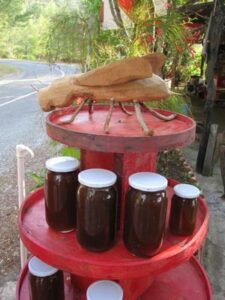
Hot Drinks for Kapha Weight Loss
Madhudaka
Hot water with one teaspoon of raw local honey.
Drink before breakfast every day for six weeks to help dissolve excess kapha.
According to Dr John Douillard, raw honey is a natural fat metaboliser and scrapes ama from the intestinal walls and from fat cells.
Weight loss Tea
Add 1 teaspoon each of fennel, coriander and cumin seed to a cup of hot water and simmer in a covered pan for 5 minutes. Strain and drink two to three times a day.
Fresh Ginger Tea
Fresh ginger is a wonderful medicine for kapha and can be taken daily as a tea and added to food preparations to increase agni, raise metabolism and burn ama.
Green Tea
Green tea is astringent, which helps to dry out excess kapha, and according to the March 2007 issue of the Journal of Nutritional Biochemistry, it helps decrease the absorption of excess fat when consumed with food. An amino acid found in green tea, theanine, increases levels of dopamine, the reward chemical and mood enhancer, and this has been shown to decrease cravings and compulsive eating. Jasmine green tea is especially uplifting and stimulating as the scent of jasmine has been shown “to mitigate the perception of work load.” This means that it could even help more lethargic kapha people perceive challenging exercise and work as desirable!
Exercise and Yoga
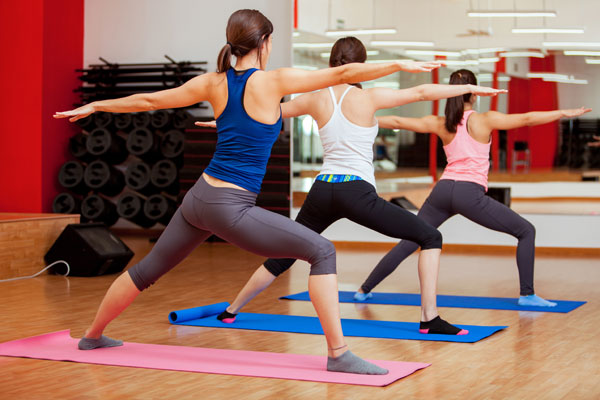
Some form of exercise is important for all doshas, but especially to help warm the body and liquefy excess kapha. Kapha people benefit from moving and energising themselves with vigorous and diverse exercise: running, playing tennis, biking, hiking, African dance and other energetic dance forms. They benefit from having friends to accompany and inspire them, and to keep them motivated, so that exercise becomes something they look forward to. More active and challenging forms of yoga including vinyasa flow, power yoga and hot yoga counteract the kapha tendency to inertia, rigidity and cold. Hot yoga is especially detoxifying and activating for kapha types, but those classes can be filled with over-ambitious pitta types unknowingly increasing heat! If you choose a simple home practice of yoga, it would be good to keep a vigorous pace and combine your practice with forceful breathing. Asanas that would be beneficial include: sun salutation, warrior, cobra, plank, bow, spinal twists, spinal roll, forward bend, backward bend, boat, half wheel, fish, child and corpse.
“Wholesome physical exercise helps the symmetrical growth of limbs and muscles while improving digestion and complexion. It reconstitutes energy making the body light, firm and compact, while safeguarding against inertia and inducing cheerfulness”
– Susruta
Neti and Nasya
Excess mucus in the nasal passages is one of the first signs of excess kapha in the body. Cleansing and purifying the nasal passages with a neti pot and a saline solution is an effective daily practice to clear congestion, prevent respiratory infections, improve the quality of the breath and enhance mental clarity. The saline solution has a drying and liquefying affect on the excess mucus. Neti can be practiced in the morning and then in the evening it can be followed by applying nasya oil to each nostril. We will describe how to do nasya below. Note that nasya is not recommended during pregnancy.
Abhyanga and Nasya for Vata, Pitta and Kapha
“The softest things in the world overcome the hardest things in the world”
– Lao tzu
Oil Massage (Abhyanga)
Massage is especially good for reducing vata, which underlies all imbalances of pitta and kapha. Calming and relaxing touch soothes emotions, and even massaging yourself gives your skin the tactile stimulation needed to balance vata and ease anxiety and stress. Using oils internally and externally (snehana) is important in Ayurveda, particularly as a prelude to detoxification and is a wonderfully relaxing and nourishing experience.
Applying warm sesame oil to the body is relaxing and rejuvenating; it increases energy flow and circulation, improves digestion, and helps the release of tension, pent up emotions and toxins. Massage with oil has a significant detoxifying effect. By stimulating the tissues under the skin, it helps prevent toxins from accumulating in the system and helps them to drain to the gut for elimination. While sesame oil is beneficial for vata, oils with qualities that reduce and pacify pitta and kapha can be specifically balancing for them.
Oils for the Doshas
Vata: Sesame, almond, castor, mahanarayan, ashwagandha, bala
Pitta: Coconut, olive, sunflower, brahmi, Bhringaraj
Kapha: Corn oil, vacha, mustard, flaxseed
Preparing the Oil
For external use, sesame oil is prepared by heating the oil in a bain marie (double boiler) with one or two drops of water until the water evaporates. Heating the oil has been shown to increase the antioxidant effect. You can then pour an ounce (25 mls) or so into a small glass bottle to keep in the bathroom. Submerge the whole bottle in a mug of hot water to warm the oil before applying it to the skin. Herbal or essential oils can be added to enhance specific desired effects: lavender oil for stress and tension, frankincense for arthritic pain, or ginger to increase the circulation.
How to Give Yourself Abhyanga
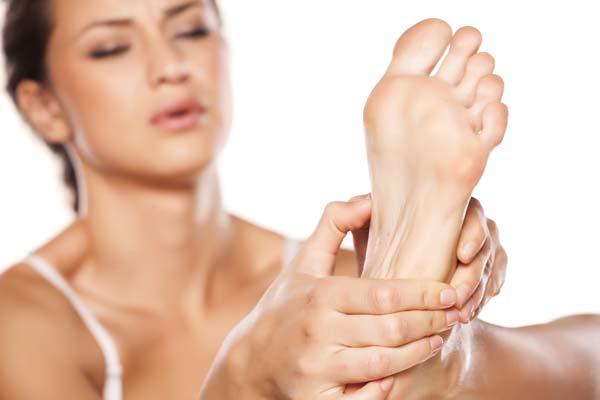
Daily abhyanga is traditionally done in the morning before bathing. To ease tension and relieve insomnia, the oil application is best in the evening before bed and should include oiling the soles of the feet. This simple 15 minute addition to your bathing routine has immediate as well as cumulative benefits. Even if you can do abhyanga once or twice a week, you will immediately notice feeling more relaxed and resilient to stress. This nurturing practice is simple and transformative. Enjoy it!
1) Start with the oil most balancing for your prakruti and vikruti. Pour some oil into a small glass or plastic bottle; sesame oil is best for dry skin, tight muscles and high vata. If you need to reduce your pitta you may benefit from a lighter, cooling oil like coconut or sunflower. Those with increased kapha may use sesame oil (sparingly), corn oil, mustard oil or massage without oil. You can design your own oil by infusing dried herbs or aromatherapy oils of your choice or specifically for your constitution, in the oil.
2) Submerge the bottle of oil in a mug of hot water to warm the oil.
3) Create a warm and comfortable space in your bathroom.
4) Massage the warm oil from the soles of your feet to your body, and from your hands and arms inward towards your chest. For your arms and legs use long gentle strokes. Massage your joints, abdomen and chest in circular movements. Reach as much of your back and spine with the oil as possible. You don’t have to do your face if you have sensitive skin and you can skip your head if you don’t want to get your hair oily. It is soothing and beneficial to massage the top of the head and ears with warm oil, if this appeals to you.
5) Allow this to be an unhurried, restorative time. You can stretch and breathe and enjoy the quiet or listen to soothing music.
6) After your body is coated lightly with oil, return to any sore or stiff joints or parts of the body that could benefit from more attention. This allows time for the oil to be absorbed and to nourish and detoxify the tissue layers. Then, bathe or shower in warm water.
7) There is no need to wash the oil off with soap. Let the hot water and steam from the shower or bath open the pores and allow the oil to soak in. (Taking a warm bath or shower after oiling rather than before is important as it opens the pores, allowing the oil to penetrate further into the body). Towel dry.
Caution: Abhyanga should be avoided in the first two trimesters of pregnancy, immediately after administering enemas, emetics or purgatives, during the first stages of fever or if suffering from indigestion.
The Benefits of Abhyanga
Supports better sleep
Decreases anxiety
Nourishes and strengthens the whole body
Increases resilience to stress
Enhances immunity
Decreases the drying effects of ageing
Increases longevity
Stimulates the internal organs and circulation
Clears toxins from the tissue layers
Keeps the joints flexible and helps prevent arthritis
“If you want to age gracefully—oil yourself everyday”
– Melanie Sachs
The Therapeutic Value of Sesame Oil
 Sesame oil is one of the most important tools of Ayurvedic medicine. It is one of the best remedies for balancing vata and since vata derangement is behind imbalances of the other two doshas, pitta and kapha, it deserves pride of place as a remedy. The rich, almost odourless oil expressed from sesame seeds is stable and contains antioxidants, which help prevent it from going rancid if properly stored, and so make it popular as cooking oil in India and China. When taken internally, cold-pressed sesame oil is used to moisten dry vata membranes and tissues and soften and loosen dry and hardened toxins. It is best taken raw 1-2 tablespoons daily.
Sesame oil is one of the most important tools of Ayurvedic medicine. It is one of the best remedies for balancing vata and since vata derangement is behind imbalances of the other two doshas, pitta and kapha, it deserves pride of place as a remedy. The rich, almost odourless oil expressed from sesame seeds is stable and contains antioxidants, which help prevent it from going rancid if properly stored, and so make it popular as cooking oil in India and China. When taken internally, cold-pressed sesame oil is used to moisten dry vata membranes and tissues and soften and loosen dry and hardened toxins. It is best taken raw 1-2 tablespoons daily.
Sesame oil is highly nutritious, rich in vitamins A, B and E as well as the minerals iron, calcium, magnesium, copper, silicic acid and phosphorus. It contains antioxidants, linoleic acid and alpha linoleic acid, as well as lecithin, and this may go some way to explaining its benefit to the brain and nervous system. Like olive oil, sesame oil is considered good for lowering harmful cholesterol levels. White seeds produce the most oil, but in India they say the best oil for healing is extracted from black sesame seeds.
Sesame oil is immensely popular in India where its use in oil massage (abhyanga) is part of everyday life and an important aspect of Ayurveda. It is the favourite oil for massage as its chemical structure gives it a unique ability to penetrate the skin easily, nourishing and detoxifying even the deepest tissue layers. In fact, it is said to benefit all the seven tissues (dhatus). It is the best oil for balancing vata but can also be used sparingly for pitta and kapha.
Used regularly, sesame oil is wonderful for reducing stress and tension, nourishing the nervous system and preventing nervous disorders, relieving fatigue and insomnia, and promoting strength and vitality. Those patients who use sesame oil daily have reported feeling stronger, more resilient to stress, with increased energy and better resistance to infection. Its rejuvenating properties ease pain and muscle spasm, such as sciatica, period pain, colic, backache and joint pain. The antioxidants explain its reputation for slowing the ageing process and increasing longevity, and certainly regular oiling of the skin restores moisture to the skin keeping it soft, flexible and young looking. It also lubricates the body internally, particularly the joints and bowels, and eases symptoms of dryness such as irritating coughs, cracking joints and hard stools.
Research into the healing effect of applying sesame oil is beginning to emerge. Those who practise it daily have found that they have less bacterial infection on their skin and that it helps joint problems. This may be related to the linoleic acid that makes up 40% of sesame oil and has antibacterial and anti-inflammatory effects. It stimulates antibody production and enhances immunity. It also has anti-cancer properties and has been shown to inhibit the growth of malignant melanoma.
Essential oils for the doshas
VATA OILS
Angelica, calamus, Himalayan cedarwood, frankincense, geranium, ginger, jasmine, jatamansi, lotus, myrrh, rose, saffron, sandalwood and vetiver.
PITTA OILS
Himalayan cedarwood, jasmine, lotus, saffron.
KAPHA OILS
Angelica, calamus, Himalayan cedarwood, frankincense, jasmine,
lotus, myrrh, rose, saffron.
How to do Nasya
Keep your nasya oil in a small dropper bottle. To warm the oil before doing nasya, place it in a mug of hot water and drop some on the back of your hand to check it is warm before applying it. A good time to do nasya is before bed and first thing in the morning before you get up. Resting comfortably on your back, tilt your head back, place five drops of oil in each nostril and sniff deeply. Rest for a few moments to let the oil penetrate. You can also use your little finger or a Q-tip to swab both nostrils with oil, making sure all surfaces are coated. Repeat this two or three times so that the oil penetrates.
Dr. Vasant Lad tells us that taking oils and medications in through the nasal passages helps to reduce sinus pain and congestion, to ease stiff necks, head and jaw pain, and to prevent glaucoma. It also has a potent affect on the doshas in the heart and mind, prana vata, sadhaka pitta and tarpaka kapha. Ayurvedic practitioner, Melanie Sachs, says that administering nasya oil at night is great for sound sleep and brings strength to the kidneys; when the kidneys rest, you rest.
Caution: Nasya is contraindicated during pregnancy, menstruation, in children under seven, during fever and directly after a neti rinse.
Charting a Path of Lifelong Health

As we navigate through the ups and downs of life, our physical and mental state is changing and adapting all the time. The balance of the doshas is dynamic and ever in flux. Over time, you will begin to see how the three doshas are working within you and to observe your inter-relatedness with the seasons, our environment and all the energetic relationships that comprise our daily lives.
While the doshas are vulnerable to being disrupted, they offer protection and a cushion to life’s stresses and uncertainties. They are working day and night on our behalf to regulate our biological processes and to create homeostasis. Since the doshas are living biological energies, there will never be a time when they are permanently in balance. Just when we feel a sense of balance and harmony, life sends us opportunities and challenges and the infinite dance of the elements and doshas continues! We can begin to see that cultivating health is an ongoing and dynamic path. The more we know about the doshas and how they function in our own body and mind, the more we can take care of ourselves and actively support this amazing process of health. By seeing ourselves through the lens of the doshas, Ayurveda teaches us that we can enhance our health and well being, our understanding and appreciation of others and ourselves, and optimise the possibility of fulfilling our potential.
New or Review Terminology
Langana
Brimhana
Shamana
Shodhana
Rukshana
Swedana
Snehana
Stambhana
Dhatukshaya
Srotorodha
Experiential Exercises
1. With the observations that you gathered from your self-assessment exercise from Chapter 18, create a treatment plan to bring any symptoms into balance. Use the resources from this chapter to determine how to prioritise what to begin avoiding and what to begin incorporating into your daily life. Do you need to treat vata first? Integrate all that you have learned so far to implement some changes in food, herbs, exercise and lifestyle into your self–care routines. Observe and record the changes you made and their effect over the days and weeks that follow.
2. If you practiced assessment skills from Chapter 18 with a friend or family member, you could practice creating a treatment plan for them based on the resources of this chapter. Begin with suggesting one or two changes and see how they work. If your friend is finding the suggestions helpful, you could continue and see how it goes. This is for your learning and it may also be helpful for your friend. Make notes about your observations and your friend’s experience in your course notebook.
3. Deepen your practice of meditation and connection with the five elements and the energy of the doshas by meditating in the natural world. This practice is balancing for all three doshas and builds on the stability of mindfulness practice. From the place of a calm and stable mind, it allows you to open to pure awareness and presence.

Meditating in the Natural World
“We could go through our whole lives without presence”
– Elizabeth Mattis Namgyel
It is not uncommon at all to be surrounded by beauty and not have the presence of mind to really appreciate and enjoy it. Just as the great mystics of ancient India retreated to remote caves and forests to abide in stillness, silence and beauty, we can greatly benefit from meditating in nature. Our practice is portable–we just need our bodies, the breath and our minds! If possible, go to a beautiful place near where you live with the intention of practicing meditation for a short time.
a. Begin by finding a place to sit comfortably, sitting upright so that you feel stable and uplifted. Notice if there is any unnecessary holding or tension and see if you can soften and relax into the sitting posture.
b. Notice your surroundings and allow your senses to be immersed in the sounds, colours, shapes and scents. Take a full breath.
c. Direct your gaze to the ground in front of you, not focusing on anything, but just resting your gaze as we do in mindfulness meditation.
d. Bring your awareness to the inhaling and exhaling of the breath. You could simply notice the breath for a short time.
e. When you notice that your mind has become distracted, simply return to an awareness of the breath as it is.
f. After a several minutes of observing the breath, raise your gaze, follow your next exhale out into the environment. Allow your exhale to expand your awareness in all directions; your breath and awareness blending with the sounds, colours, movements and presence of the natural world.
This meditation practice is sometimes called “blending awareness with space”. Our own awareness becomes infused with the expansiveness of the sky and the scenery. It is like pouring water into water. You can also do this meditation lying down with your eyes closed at first while observing the breath for 5 or 10 minutes or so. Then open your eyes and follow your exhale out into the space around you. You can repeat this process of focused meditation on the breath and then expanding awareness out into the panorama.
The natural world that surrounds us radiates presence and awareness. When we blend our awareness with this simple and majestic presence, we become more naturally who we are as a part of all that is. Meditation practice, you could say, is about becoming more natural and at ease.
“Once we become familiar with the breath, we realise that the breath and the present moment have become synonymous”
– Sakyong Mipham Rinpoche
4. Share an experience or ask a question on the Living Wisdom Forum.

